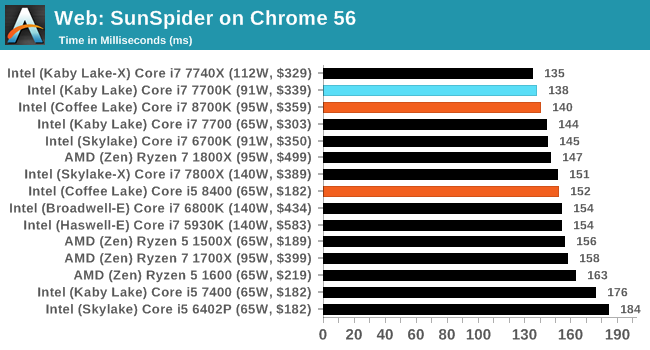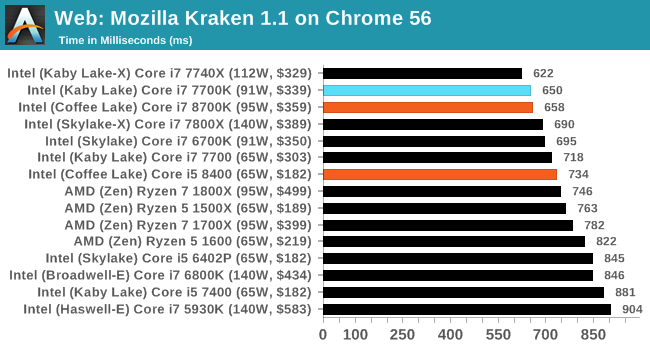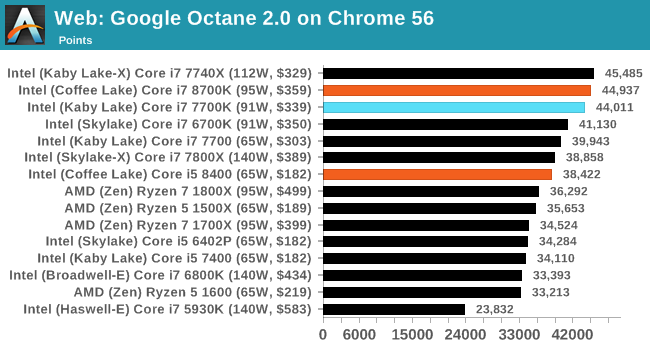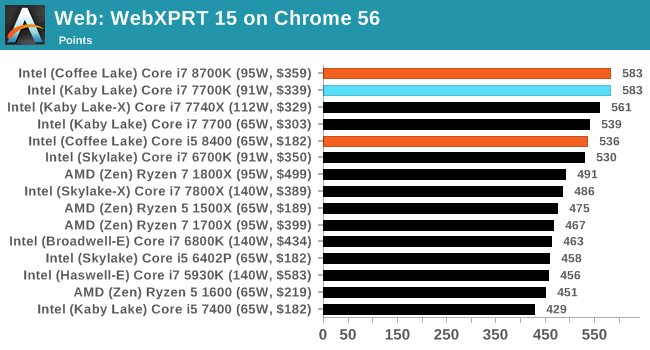The AnandTech Coffee Lake Review: Initial Numbers on the Core i7-8700K and Core i5-8400
by Ian Cutress on October 5, 2017 9:00 AM EST- Posted in
- CPUs
- Intel
- Core i5
- Core i7
- Core i3
- 14nm
- Coffee Lake
- 14++
- Hex-Core
- Hyperthreading
Benchmarking Performance: CPU Web Tests
One of the issues when running web-based tests is the nature of modern browsers to automatically install updates. This means any sustained period of benchmarking will invariably fall foul of the 'it's updated beyond the state of comparison' rule, especially when browsers will update if you give them half a second to think about it. Despite this, we were able to find a series of commands to create an un-updatable version of Chrome 56 for our 2017 test suite. While this means we might not be on the bleeding edge of the latest browser, it makes the scores between CPUs comparable.
All of our benchmark results can also be found in our benchmark engine, Bench.
SunSpider 1.0.2: link
The oldest web-based benchmark in this portion of our test is SunSpider. This is a very basic javascript algorithm tool, and ends up being more a measure of IPC and latency than anything else, with most high-performance CPUs scoring around about the same. The basic test is looped 10 times and the average taken. We run the basic test 4 times.

Mozilla Kraken 1.1: link
Kraken is another Javascript based benchmark, using the same test harness as SunSpider, but focusing on more stringent real-world use cases and libraries, such as audio processing and image filters. Again, the basic test is looped ten times, and we run the basic test four times.

Google Octane 2.0: link
Along with Mozilla, as Google is a major browser developer, having peak JS performance is typically a critical asset when comparing against the other OS developers. In the same way that SunSpider is a very early JS benchmark, and Kraken is a bit newer, Octane aims to be more relevant to real workloads, especially in power constrained devices such as smartphones and tablets.

WebXPRT 2015: link
While the previous three benchmarks do calculations in the background and represent a score, WebXPRT is designed to be a better interpretation of visual workloads that a professional user might have, such as browser based applications, graphing, image editing, sort/analysis, scientific analysis and financial tools.











222 Comments
View All Comments
sirmo - Thursday, October 5, 2017 - link
No temperature comparison? According to some reviews I see Intel stubbornly continues to rely on their horrible TIM solution, after my horrible experience with Haswell overheating I am not considering Intel again in my build until this is fixed. There is nothing worse than when your build starts crashing because of overheating 2 years down the road.shreduhsoreus - Thursday, October 5, 2017 - link
The 8100 is basically a 6600 locked at it's quad core turbo frequency. Pretty decent for $120.Gordo-UT - Thursday, October 5, 2017 - link
Looking at these results, there is still no reason to migrate from my i7-2600k. Still running at 4.6 Ghz for years now, flawlessly with equal or better performace of all that came after. It would seem Moore's law failed to hold true for the past 5 years.For the price of a new i7, you can buy a used i7-2600k, z68 or z77 mobo, and 16 gb ram. It looks like that situation will not end soon.
Intel has to give me a compelling reason to spend a ton of money on NEW stuff.
vanilla_gorilla - Thursday, October 5, 2017 - link
"It would seem Moore's law failed to hold true for the past 5 years."Moore's Law is about transistor density, not performance.
mapesdhs - Friday, October 6, 2017 - link
For quite a lot less than a new i7, I bought a 3930K, ASUS R4E and 16GB/2400 RAM. And a 120mm AIO. And a 2nd R4E. :DCompelling reasons are perhaps more likely to come from peripheral and I/O scenarios, eg. if one wants the latest USB 3.1, M2 or somesuch. However, addin cards solve most of these, and numerous SB/SBE boards can now boot from NVMe. I saw great numbers with M.2 drives and Z68, and because of the wiring it should be possible for an M4E to use an M2 as boot and have two GPUs at x16 (aka 3.0 @ x8, same as modern mainstream split), while X79 has enough lanes anyway.
mapesdhs - Tuesday, October 10, 2017 - link
(btw, when I say a lot less than a new i7, I did mean the 8700K)SuperRobomike - Thursday, October 5, 2017 - link
5930k does surprisingly well compared to the 8700k in the gaming benchmarks (at least for the games tested). Any particular reason it would be doing so well? Can't think of any advantage it would have besides the quad channel memory.CTHL - Thursday, October 5, 2017 - link
Why are all these benches between sites so wildly different (with supposedly same settings/specs). RoTR has had some of the most absurd results... one has 8700k beating everything by 20fps, another has 7700k over 8700k by 40fps, and one even had a 6600k beating everything.firerod1 - Thursday, October 5, 2017 - link
i5-8400 is King performance/dollar!watzupken - Saturday, October 7, 2017 - link
The i5 8400 looks like a good value processor until you factor in the price of a Z370 motherboard which is the only chipset available.